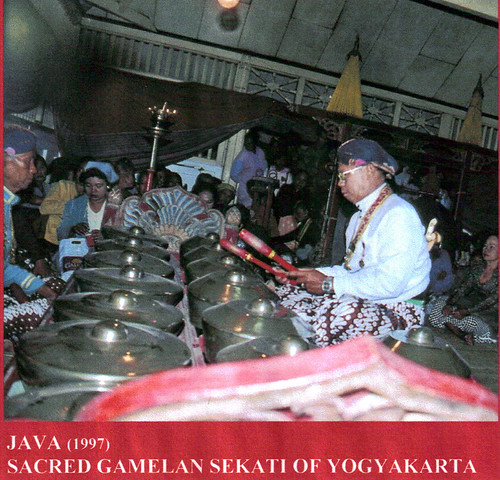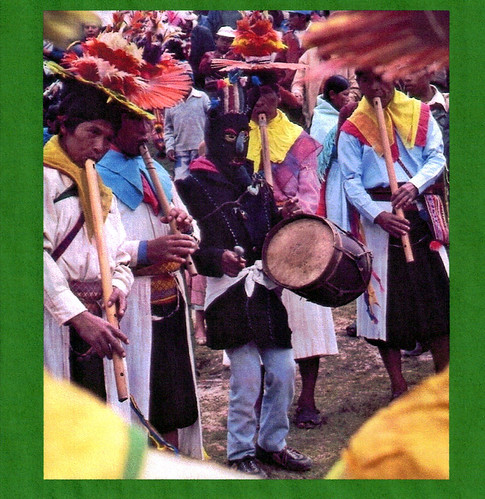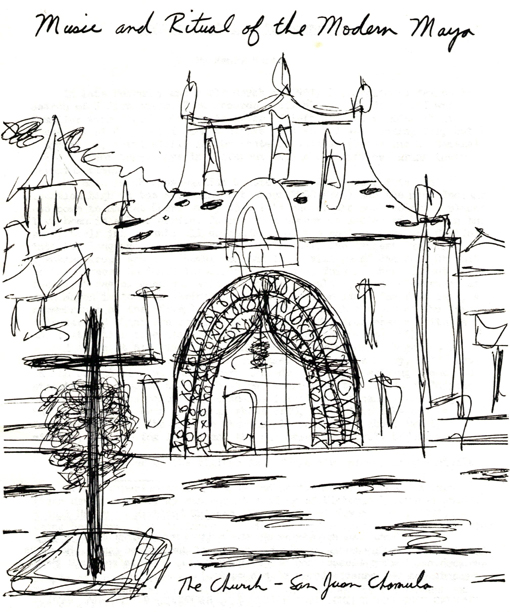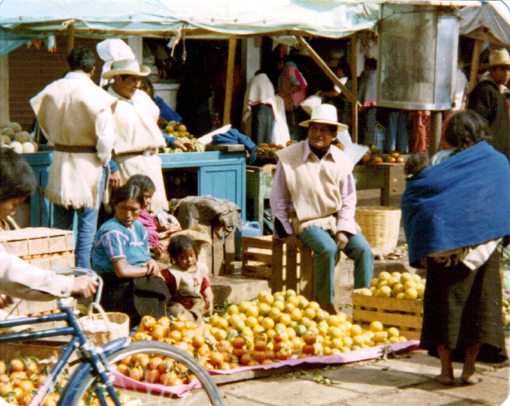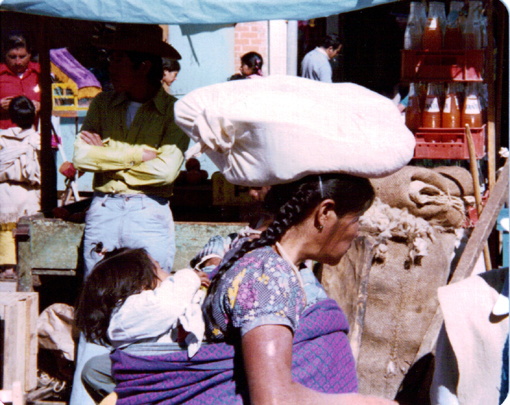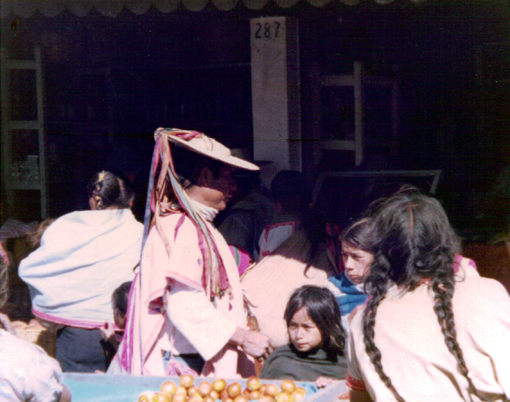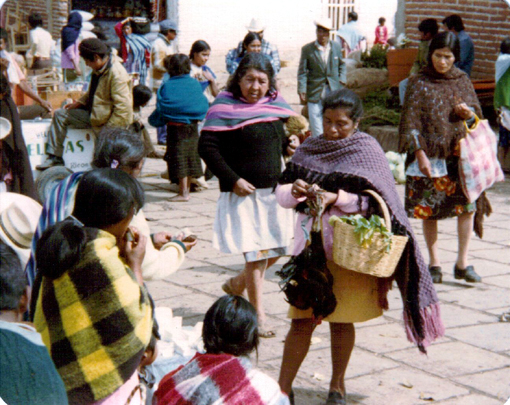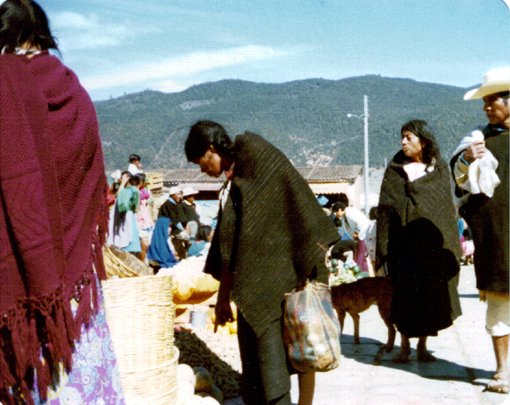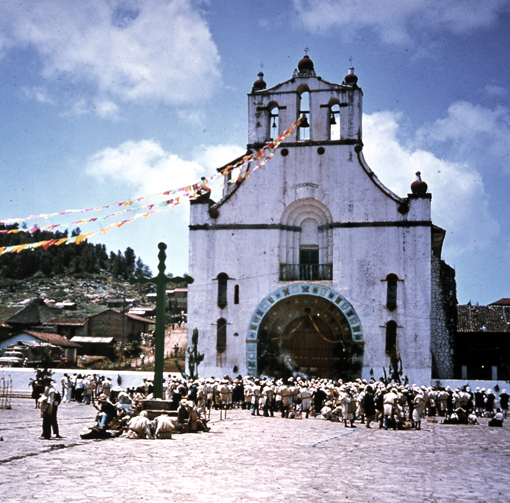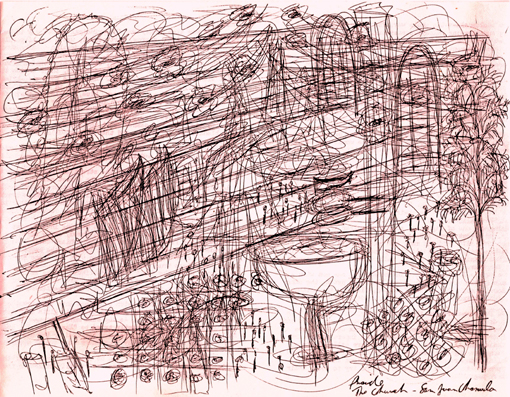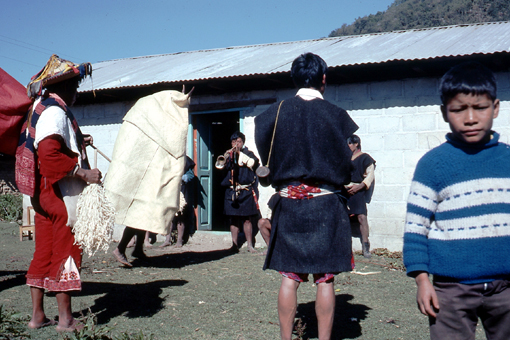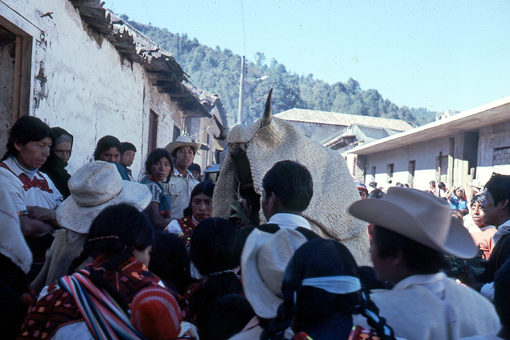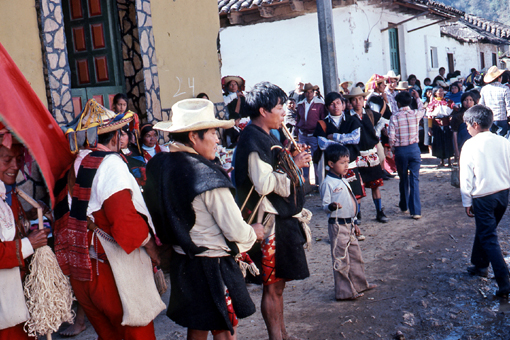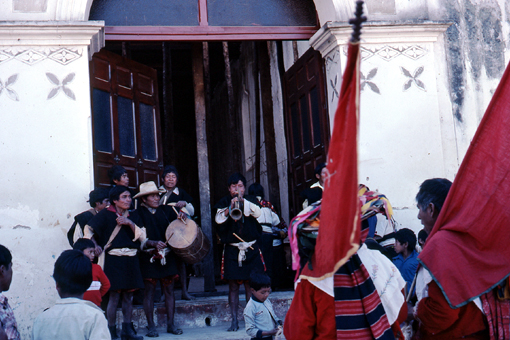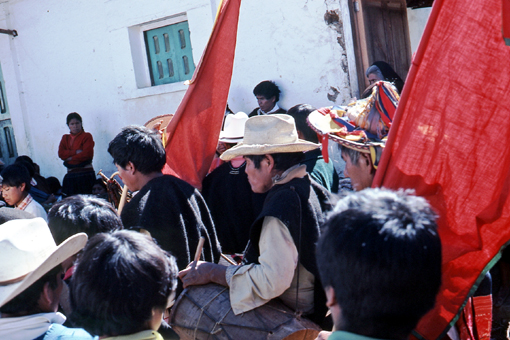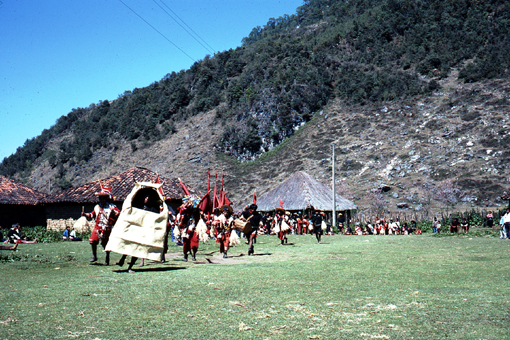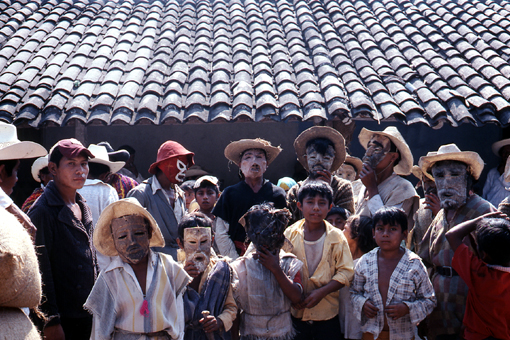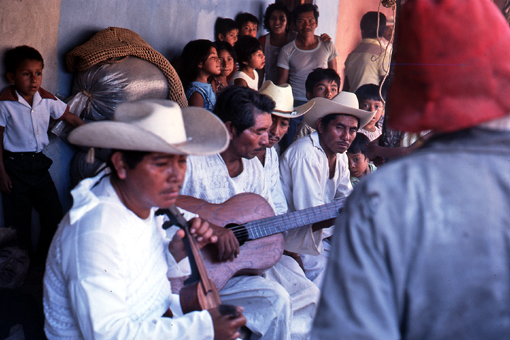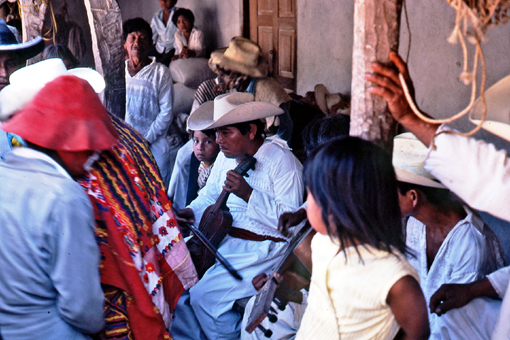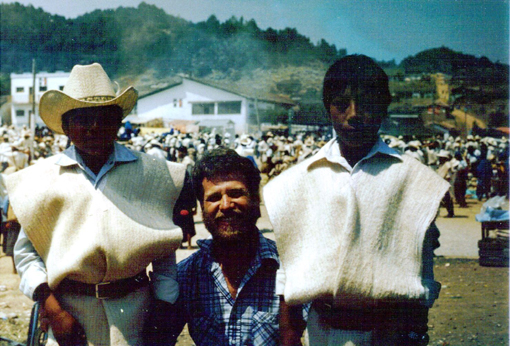JAVA (1997)
Sacred Gamelan Sekati of Yogyakarta
Humming Bird Earth Series CDR 1
Note: This music was recorded in open-air pavilions on basic equipment under conditions far from optimal for recording. Yet the ambience, excitement, and electricity of the music shine through in ways that fully reflect its cultural authenticity. Earth Series is releasing this material because of its uniqueness and general unavailability on the commercial market.
1. Kyai Gunturmadu July 13, 1997 – 10:30 PM (22:49) | 2. Kyai Nagawilaga July 15, 1997 – 11:00 PM (24:53) | 3. Kyai Gunturmadu July 16, 1997 – 9:00 PM (29:34)
listen to Java | Kyai Gunturmadu July 13, 1997
Instrumentation – 7 tone pelog tuning Bonang Barung 2 rows of 14 knobbed gongs, plus one on each side of the main seated player: played by1 leading player and 1 or 2 additional players who sit on the opposite side of the instrument adding occasional ornamentation. Saron Demung, 2 Saron Ritjik, Saron Peking Metallophones of graded sizes suspended over wooden trough resonators: Each saron may be played by 1 or 2 players, the players sitting on opposite sides of the instrument. Kempiang 2 knobbed gongs on a wooden stand: 1 player. 2 Tjempur small suspended gongs: 1 player. 2 Gong Ageng large suspended gongs: 1 player. Bedug large drum: 1 player.
On my initial visit to Yogyakarta, Central Java, in 1987, there was one type of gamelan music I did not hear anywhere. That was the unusual and extraordinary music of the ancient and sacred gamelan sekaten. Prior to my journey, I had heard this music on an LP Java / Historic Gamelans (UNESCO Collection, GREM G1004) recorded in 1970 by Jacques Brunet.
I hadn’t realized at the time that the music of that gamelan – Kyai Gunturmadu (the Venerable Torrent of Honey) – and that of its twin, Kyai Nagawilaga (the Venerable Fighting Serpent) is heard publicly only once each year – on the six days and nights that precede the Javanese celebration of the birth of the prophet Muhammad.
On the evening before the public playing begins, the two gamelan sekati are played in the palace compound of the Sultan of Yogyakarta, then carried in procession to the outer courtyard of the royal mosque and placed in opposite pavilions. That is where they are played alternately from morning until late evening for the six days.
In 1997, I returned to Yogyakarta at the time of this celebration to immerse myself in the music of the two ancient gamelans.
What is so special about the music of the gamelan sekati?
It is played on the largest and loudest Javanese instruments, yet it is the slowest, most spacious, and perhaps most internally complex of any Javanese music. It is characterized by odd phrasings and intervals, strange rhythmic markings and interjections, and sharp punctuations both on and off the beat. At the same time, the music is deeply spiritual in intent and is profoundly moving.
Historically, since the 16th century, the gamelan sekati have been associated with religious ritual. This association was allowed by Java’s new Islamic rulers as a concession to indigenous Javanese culture; it was encouraged by them with the hope that the sound of the gamelan might help attract converts to Islam. The word sekaten itself, after which the festivities associated with the gamelans is named, derives from a word meaning a profession of faith in Allah.
Since the gamelans almost certainly existed prior to the arrival of Islam, one would think that music for the ensembles must have existed as well. One wonders if the playing of the gamelans might originally have been associated with the week-long harvest festival that took place in pre-Islamic Java, the timing of which was changed to coincide with the sekaten celebration commemorating Muhammad’s birth.
The origins of the present-day gamelan sekati instruments, however, only partly go back to the (pre?) 16th century. The two sets of gamelan instruments that were used for the first sekaten celebration belonged to what was then the central Javanese kingdom of Mataram. In 1755, under Dutch supervision, that kingdom was split into the two less powerful principalities of Yogyakarta and Surakarta. As a result of the division, the Mataram heirlooms – which included the two gamelan sekati – were also split.
So Yogyakarta and Surakarta each inherited one of the original sets of gamelans, each set carrying the same honorific title of Kyai Gunturmadu. Each principality also constructed a second identical sekaten gamelan to go with the first. In Yogyakarta, that was Kyai Nagawilaga which was completed in 1757.
These are the gamelan sekati that are used today in the week-long celebrations that take place in both Yogyakarta and Surakarta.
Until now, the only recordings of the music of the Yogyakarta gamelan sekati were made in 1970 – of Gunturmadu, one track on the previously mentioned (and out-of-print) Java / Historic Gamelans – and of Nagawilaga, one track on a CD released in 1995, JAVA, Palais Royal de Yogyakarta 3: Le Spirituel et Le Sacré (Ocura C560069), also recorded by Jacques Brunet.
There are also wonderful recordings from the 2001festival of the two gamelan sekati of Surakarta (one track each) by John Noise Manis. They are included on a CD Gamelan of Central Java II: Ceremonial Music (Dunya/Felmay FY8042). What one hears is that the Surakarta style of playing is different than that of Yogyakarta. It is lighter in tone with a different balance of nuances. Also, to go by one of the photos in the CD booklet, the Surakarta gamelan sekati appear to include some instruments not included in Yogyakarta.
Which leads to the reasons for the present release –
Originally, these were recordings I made for my own use and reference – what one might call basic “field recordings.” My decision to release them is because they reveal something fundamental about the music of the Yogyakarta gamelan sekati that the 1970 recordings, as sonically and musically excellent as they are, do not.
These are the first released recordings of the Yogyakarta gamelan sekati in ritual use. The 1970 Brunet tracks brilliantly documented the sound, textures, and musical sense of the gamelans, with the compositions standing in high relief. The inherent time restrictions of the LP were perhaps perfect for that, but the tracks (at just over 17 and 13 minutes) are considerably shorter than nearly any of the performances I heard.
Brunet reports that in 1995 there were only fourteen musical compositions in the repertoire of the gamelan sekati. What one realizes on hearing the gamelans in performance is that for all their individual interest, the compositions are only a means, a medium if you will, for attaining and maintaining a finely tuned spiritual state. The compositions may be played for longer or shorter durations depending upon ritual need.
Further, the day-to-day use of the gamelan sekati instruments in performance affects the overall sound of the music. For example, when the bronze keys of the sarons (each key of which fits over two metal posts that jut out of the wooden troughs on which they sit) are continually struck by the players’ heavy lead-weighted buffalo horn mallets, there is a persistent metallic buzz (scarcely audible on the Brunet recordings) that almost begins to sound like the built-in buzz of a marimba.
Also, because until now there has been only one recording each of each Yogyakarta sekaten gamelan (i.e. no comparative recordings), we have not been able to get a sense of what we begin to discern on the present disc – how the character of each piece is determined to a large extent by the playing of the ensemble’s nominal leader, the player of the bonang.
Of the three pieces presented, we hear three different compositions led by three different players. Each leading player plays a similar introduction in terms of notes, but each one plays those notes with a different cadence and feeling. You would think this difference might be attributable to the compositions themselves, but my experience of hearing the players over several days suggests otherwise.
The peculiar aspects of each composition do not actually begin to assert themselves until several minutes into each piece – at around the 6th minute of the first piece, at around the 7th minute of the second, and at around the 10th minute of the third.
The first piece, played on Kyai Gunturmadu, moves into a heavenly, near ecstatic state of being. The simultaneous striking of various knobbed gongs, not unlike the use of the reong in Balinese music, contributes in no small part to this atmosphere. (Toward the conclusion of a piece played on Kyai Gunturmadu the previous evening, the sound of the gamelan was so incredibly strong yet sweet that the Javanese audience, thickly crowded around the pavilion, was smiling broadly and laughing in recognition of its power and charm.)
The second piece, on Kyai Nagawilaga, sustains a rarefied, near rapturous air, with an unusually high-pitched edge; it descends to earth with a precise, clockwork-like finish.
The third piece, on Kyai Gunturmadu, is the real gem of this collection. It is the final full-length piece of the six days – only an abbreviated 10-minute piece followed – played just prior to the royal attendants showing up to return the gamelan in procession to the Sultan’s palace.
The pavilion, the space between the two pavilions, and the entire surrounding area was dense with people. Many had come from villages near and far away to bathe in the spiritual sounds of the gamelan sekati and to participate in the festival’s grand finale the following day. (On that day, mountains of rice are carried from the Sultan’s palace and given away to the people who believe that partaking of the rice will bring prosperity and happiness.) So there was a pervasive murmuring and excitement in the air as the piece began.
The leader of this piece (pictured on the cover) I considered to be one of the great masters of this genre. He had the ability, as you can hear, to slow the music down to the point of inner stillness – like the stillness in the center of a Buddhist painting. But even as the music slows down – and it seems to slow down more as it moves along – it retains a high degree of complexity.
One keeps thinking that the music is going to settle somewhere, like into an ancient “groove” – but there are unexpected twists and turns, odd rhythmic accents, contrary beats, unusual stops, pauses, punctuations, and breaks in cadence. There is a point somewhere in the piece’s final minutes when the bonang and the sarons seem nearly to be moving in opposite directions. The effect of the whole is both musically masterful and deeply moving.
For me, this piece is the essence of what the music of the gamelan sekati is about. (Henry Kuntz, July 2009)
Recordings and Photos by Henry Kuntz. Digital Audio File by Michael Zelner. C & P Humming Bird Records 2009 – All Rights Reserved
ADDENDUM: Since the release of JAVA (1997), a new CD, Gamelan Of Central Java XIV: Ritual Sound Of Sekaten (Felmay Records), has appeared, featuring comparative recordings from 2004 of the gamelan sekati Gunturmadu of Yogyakarta and Surakarta. There is one recording by each ensemble playing the same composition, Gendhing Sekaten Rangkung, said to be one of only two specifically composed for the sekaten gamelan. The two compositions date from the early Islamic period.
The playing styles and musical approaches of each group are remarkably different. The recordings by John Noise Manis are excellent.
The composition itself seems to be the same as that featured on piece # 2 of JAVA (1997) played by gamelan Nagawilaga.
BOLIVIA (1986)
Native Ritual Music from Italaque: Panpipes, Flutes, Drums
Humming Bird Earth Series CDR 2 (Previously Earth Series Cassette 300)
Note: All of this music was recorded outdoors on basic equipment in “real life” circumstances, under conditions far from optimal for recording. Yet the ambience, excitement, and electricity of the music shine through in ways that fully reflect its cultural authenticity. It is to provide a small cultural looking glass into a world or worlds barely known to most of us that these recordings are presented. I hope they will encourage you to want to know more, to open your world up more to the many fascinating and diverse worlds around us.
Music from the Fiesta de la Invención de la Santa Cruz May 3, 1986
1. Group One (2:41) 2. Group One (2:25) 3. Group Two (3:22) | 4. Group Three (2:33) 5. Groups One & Three (10:09) | 6. Group Four (1:43) 7. Group One (5:20) | 8. Groups Two, Three & Four (8:30) 9. Groups Three & Four (8:50)
listen to Boliva | Group One
listen to Bolivia | Group Two – Alto Bamboo Flutes
Group One plays large single-row panpipes of seven different-length tubes each. Pieces 1 and 2 were recorded on the group’s arrival and departure from the small courtyard. Group Two plays 5-hole straight flutes, each some 2 feet long. Piece 3 was recorded on their arrival in the small courtyard. Group Three plays two sizes of 4-hole straight flutes, one approximately 2 feet long and the other closer to 3 feet. Piece 4 was recorded on their arrival in the small courtyard. Group Four plays relatively small single-row panpipes of different sizes with different-length tubes in groups of 6, 9, and 12. Piece 6 was recorded on the hill overlooking the town, as were all of the remaining pieces featuring all of the different groups.
Various types of drums and snare drums of all shapes and sizes can be heard prominently featured on all of these recordings.
The village of Italaque is set alongside a river in a high Andean valley some two to three thousand feet below the Bolivian altiplano (or “high plane”), itself some 12,500 feet above sea level. It is 25 kilometers northeast of Puerto Acosta, not far from the Peruvian border, on the eastern (and less-visited) side of Lake Titicaca. It is reached via an occasional (all day) truck ride from La Paz or by a seven to eight-hour foot path from Puerto Acosta, which is the way I and an Australian friend of mine, Patrick Hanson, arrived.
The native people of the region are Aymara-speaking, and for the feast of the “Discovery of the Holy Cross,” May 3, groups of musicians came to Italaque from several area villages to take part in religious and ritual observances. In Lynn Meisch’s Guide to El Dorado and the Inca Empire, where I first learned of this festival, she refers to the goings-on as a contest of sorts among groups of sikuri (zampona or panpipe) players previously trained in Italaque, but this seems to no longer be the case. At least in 1986, there were only two groups of sikuris— one played quite large panpipes and the other from Italaque played smaller ones— and there were three other groups which played straight wood (bamboo) flutes of varying types and sizes. Although the several groups frequently played their own music at the same time right next to each other, there was no apparent competition between them, at least none that was apparent to an un-acculturated outside observer. Rather, there was only a dizzying and outrageous mix of sound, of varying sorts and in varying chance combinations, never the same twice!
The festival took place on a high hill and precipice that overlooks the town. The hill, known as Calvario, was the site of a very small chapel and courtyard. Early in the day, each of five musical groups (except for the one from Italaque, the event’s organizers) took a place somewhere on the hillside below, performing their own ritual observances (including the drinking of an overpoweringly strong white grape brandy which they continued drinking intermittently throughout the day) and preparing themselves for the hours of playing to come. One by one, they moved rapidly up the hill, playing their panpipes, flutes and drums. Ritual prayers and playing took place in the small courtyard and chapel, the groups forming circularly and moving circularly, first this way and then that, as they played. They then filed out onto the precipice of the hill where they continued to play, with only short breaks, the remainder of the day.
Each of the groups was composed of some fifteen to twenty-five male musicians. They were dressed in different, though similar, costumes, presenting an array of colors. Some wore hats decorated with numbers of tall multi-hued feathers. One group used only flamingo feathers, making for a sea of soft pink. Two of the groups wore as well a type of “woman’s” wig, straight black hair pulled back with a single thick braid behind! The group with the flamingo feathers wore a type of open-front, thin white cassock, nearly dress-like at the bottom, on top of which they wore dark blue suit coats. By way of difference, the group from Italaque wore suits (or coats) and occasionally ties, and dress hats (!), while still another group wore the white cassocks, but without the coats, almost “oriental” looking.
Indeed, some of the music itself (tracks 3 and 4 e.g.) had a quality, an elegance even, not unlike a type of Japanese or Korean court music — highly stylized, insistent, and nearly trance-like in nature — music, like all of the music heard here, from a dimension far removed from itself as music alone. For here, unlike most native festivals, the music was the main event, it was not an accompaniment to anything other than itself. Its only connection to any ritual outside of itself was that it was this day of ritual that had brought it into being and it was responsible to it, but the music was played and entered into on its own terms. In the first instance, this was a musician’s festival.
The groups were, however, accompanied by various mythological and ritual characters. There were two men costumed in huge black-and-white condor feathers wearing a type of hood over the face with a small, rectangular mirror in the center, representing perhaps Inti, the sun, and also perhaps to ward off evil influences. There were other characters, more like “ritual humorists” (I borrow the term from Victoria Bricker who used it in Ritual Humor in Highland Chiapas, University of Texas Press): a couple of masked and hooded personages with a type of ski-mask over their faces, devilish sorts with short rope whips and small bells (heard at various points in the recordings). The function of the “ritual humorist” is to add a certain levity, to poke fun at participants and bystanders, to alleviate or contradict the serious nature or thrust of any event and, frequently, to reinforce (by contrast) accepted community values. These types of characters are common at native festivals throughout the Americas.
When the groups had all paid their respects in the courtyard and chapel and had all finally moved out onto the small precipice, the music really took off. There were hours of interactions of sound, mixes and movements of color (from the musicians’ costumes and feather headpieces and the circular turning of the groups). It was like the wildest dream of sound, a perfect mix of the earthy and the ethereal, the tops of rugged Andean peaks and wisps of high altitude clouds readily visible in the distance. (Henry Kuntz, 1986)
(Note: Although I’ve mentioned that five groups took part in this event, two of the groups appeared to be from the same village and were similarly costumed and played the same music. So only “four” groups are represented on the recording. A sixth group, not represented on tape, appeared somewhat late in the day, playing in a style similar to Group Four, the group from Italaque.)
Recordings and Photos by Henry Kuntz. Digital Audio File by Michael Zelner. C & P Humming Bird Records 1986/2009 – All Rights Reserved
For more photos and to read the complete story of Henry’s Journey to Italaque (Parts 1-4), go to Sax & Stories by clicking here…
The complete Humming Bird Records catalogue is available in my Record Shop here… and also via Metropolis | The Shop here…

